Artificial grass, also known as synthetic turf, refers to man-made surfaces made to emulate natural grass. It is most often used in sports arenas and residential landscapes. The origins of artificial grass date back to the 1960s when it was first created as a substitute for natural lawn by a team headed by David Chaney. Their synthetic grass was made of nylon implanted with blades of green plastic to resemble grass. It was first installed in the newly constructed Houston Astrodome in 1966 due to difficulties growing natural grass indoors under artificial lighting. This pioneering artificial turf was called "Chemgrass."
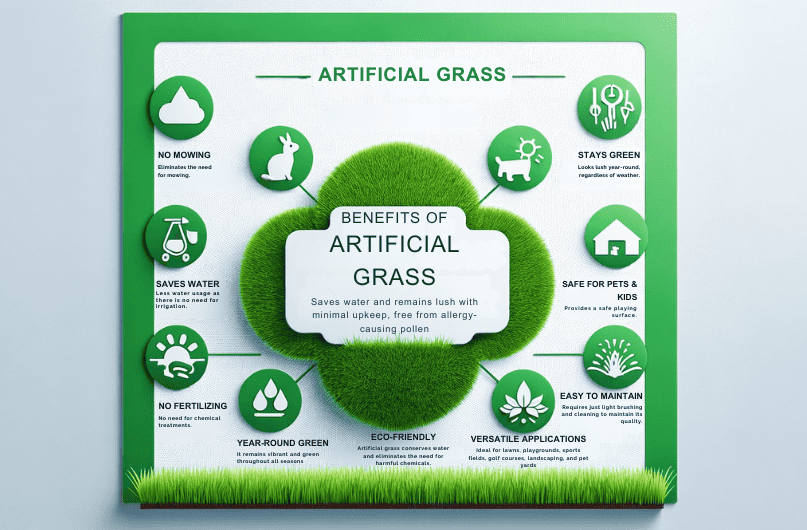
Since then, artificial grass technology has continued to advance. The materials used have evolved from nylon and plastic to more sophisticated polyethylene and polypropylene materials. Manufacturing techniques have also improved to produce blades that are more realistic and durable. Today, artificial grass is becoming increasingly popular for residential and commercial applications as a low maintenance, environmentally friendly alternative to natural grass. From sports fields to backyards, artificial turf offers benefits like constant green color, durability, and water savings. This guide provides a comprehensive overview of artificial grass for homeowners considering installing it in their landscape.
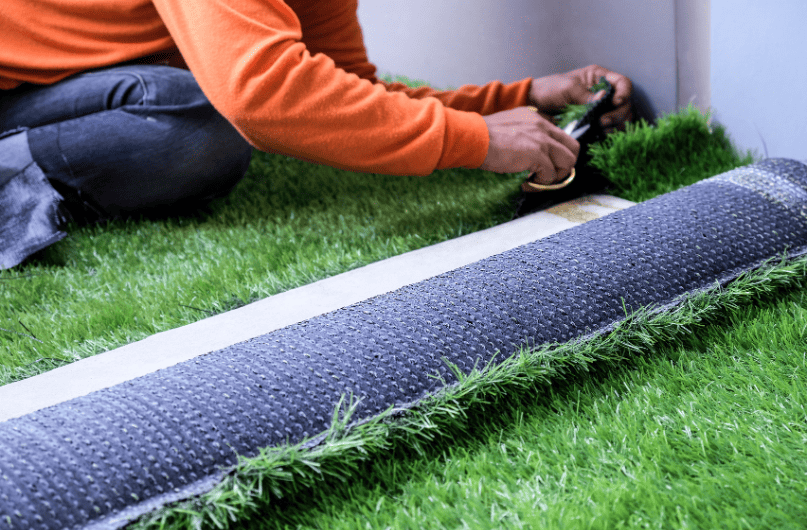
One of the biggest advantages of artificial grass is that it requires very little maintenance compared to real grass. Once artificial turf is installed properly, it does not need to be watered, mowed, or fertilized. The synthetic blades retain their fresh, green appearance year-round regardless of weather conditions.
Artificial grass also provides a lush, attractive look that resembles a natural grass lawn. The newest turf products feel soft underfoot yet are durable enough for active play. The quality synthetic fibers are designed to emulate the texture and appearance of real blades of grass. Many homeowners are unable to tell the difference from a distance.
The built-in drainage systems in artificial turf allow rainwater to pass through quickly so the lawn does not get muddy or flooded. This makes artificial grass a safe, clean, and comfortable surface for kids and pets. There are no muddy paws or grass stains to worry about. Due to its low maintenance nature, artificial grass offers homeowners more time to enjoy outdoor living spaces without labor-intensive lawn care.
One of the biggest advantages of artificial grass is the cost savings compared to natural grass. With artificial turf, there is no need for regular mowing, watering, or fertilizing. These services can add up over time and be a continual expense for homeowners.
Artificial grass only requires an occasional rinse to keep it looking clean, saving you time and money on lawn maintenance over the years. The upfront installation cost of artificial turf may be more than sodding a new lawn, but artificial grass has a lifespan of 15-25 years depending on the quality. This longevity makes it cheaper in the long run compared to repeatedly re-sodding and renovating a natural grass lawn every 5-10 years.
Additionally, artificial lawns retain their vibrant green color regardless of weather conditions. Natural grass can turn brown during hot, dry periods requiring extra watering costs. If you live in a region with water restrictions, artificial grass is an especially good choice since it doesn't need irrigation after installation.
With artificial turf, you'll no longer have surprise costs from lawn care services or wasted water keeping natural grass green. The durable artificial blades withstand heavy use and retain their appearance better than real grass under high traffic. While the installation cost is an investment, artificial grass saves substantially on regular maintenance and avoids the need for repeated renovations over time.
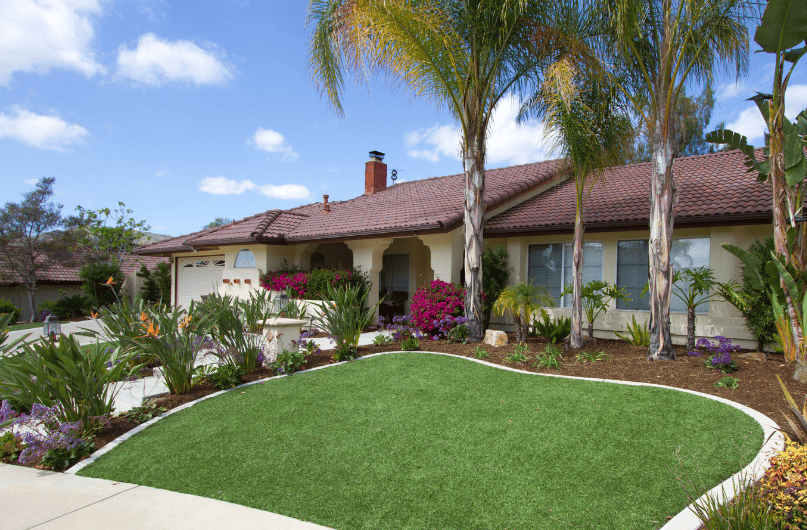
Installing artificial grass provides a number of environmental benefits compared to natural grass lawns. Artificial turf significantly conserves water usage since it does not require regular irrigation or watering to stay green and lush. This can lead to substantial cost savings on your water bill over time.
Additionally, artificial grass eliminates the need for pesticides, fertilizers, and other chemicals that are commonly used on traditional lawns. Runoff from these products can pollute local waterways and contribute to environmental degradation. Going with a synthetic turf helps protect the health of nearby ecosystems.
At the end of its lifecycle, artificial grass can also be fully recycled and kept out of landfills. The polyethylene fibers are broken down and reused to create new products, reducing waste. Natural grass clippings and debris inevitably end up in the dump.
By installing artificial grass, homeowners can benefit the environment through reducing water usage, eliminating lawn chemicals, and decreasing waste. Your outdoor space remains beautiful and lush while protecting local ecosystems and resources.
One of the best features of artificial grass is that it can be used in so many different applications, both for residential and commercial uses. Unlike natural grass that works best for lawns and yards, artificial turf can be used to create stunning landscapes in settings that real grass just won't work.
For homeowners, artificial lawns are an excellent alternative to natural grass for their yards and lawns. The artificial blades perfectly recreate the look of lush, green grass without any of the mowing or watering required for the real thing. Artificial lawns are durable enough to handle all kinds of activity, from kids playing to backyard barbecues and patio furniture. The synthetic grass allows homeowners to enjoy a perfect looking lawn year-round regardless of weather or climate.
Beyond home lawns, artificial turf is also the ideal surface for playgrounds, sports fields, and athletic facilities. The synthetic blades are soft and cushioned enough for children's playgrounds as a safe alternative to wood chips, sand, or pea gravel. For sports like football, baseball, field hockey, and more, artificial turf allows year-round use regardless of weather. The consistent surface is safer for athletes and allows for truer bounces and rolls of balls. Artificial grass doesn't get muddy or freeze over, so games and practices can continue even when natural grass would be unusable. The low maintenance requirements also make artificial turf perfect for schools and recreational facilities.
Artificial grass isn't just for lawns and sports fields. Many homeowners choose to use artificial turf for landscaping areas like gardens, patios, walkways, and poolsides. The synthetic material adds a lush, green touch while still allowing other plants like flowers and shrubs to thrive. Using artificial grass in landscaping allows homeowners to cut back on water usage while still enjoying the beauty of green spaces. For areas like golf courses, parks, attractions, and more, artificial grass offers unlimited possibilities for creative and lush landscaping designs that would be impossible to maintain with natural grass.
Unlike natural grass which produces pollen and irritates allergy sufferers, artificial grass is allergen free. With no grass blades or pollen, artificial lawns won't trigger any allergic reactions or asthma. This makes artificial grass a great option for anyone with grass allergies, seasonal allergies, or respiratory issues aggravated by pollen. Kids and adults who suffer from hay fever, allergies, and asthma can play on an artificial lawn without worrying about stuffy noses, itchy eyes, rashes, or breathing issues. An artificial grass lawn provides a safe outdoor space for the whole family to enjoy.
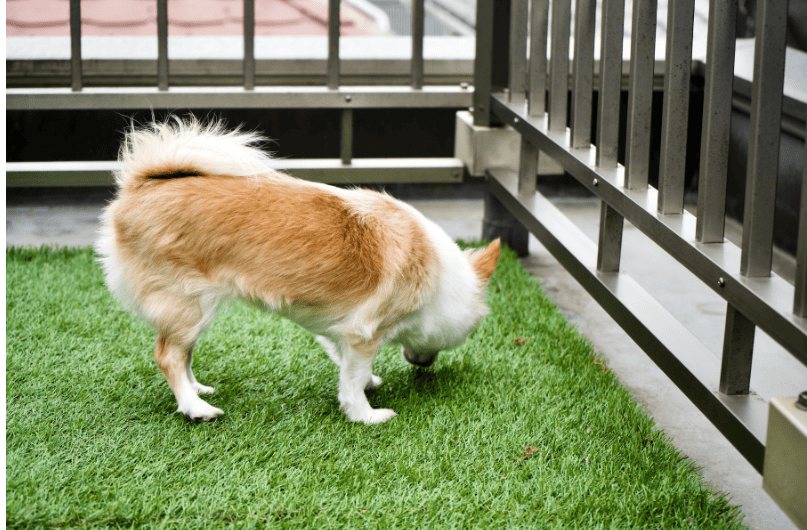
Artificial grass is highly durable and stands up well to pet traffic and activity. Unlike natural grass, it won't get muddy or turn into dirt patches from excessive pet use. Artificial turf is designed to replicate the look and feel of real grass, while being much more resilient.
Pet messes are also no problem with artificial grass. Urine drains through the turf and away from the sub-surface, so it doesn't leave unsightly yellow spots or lingering odors. Any solid pet waste can be easily removed and the grass hosed off. The artificial blades do not absorb liquids or stains like real grass does. This makes artificial lawns much simpler to clean and maintain with pets.
Artificial grass offers a clean, attractive and comfortable surface for dogs and cats to play and do their business on. Pet owners don't have to deal with constantly repairing dug up areas or replacing grass worn down by pets. Their animals can enjoy an outdoor space made just for them.
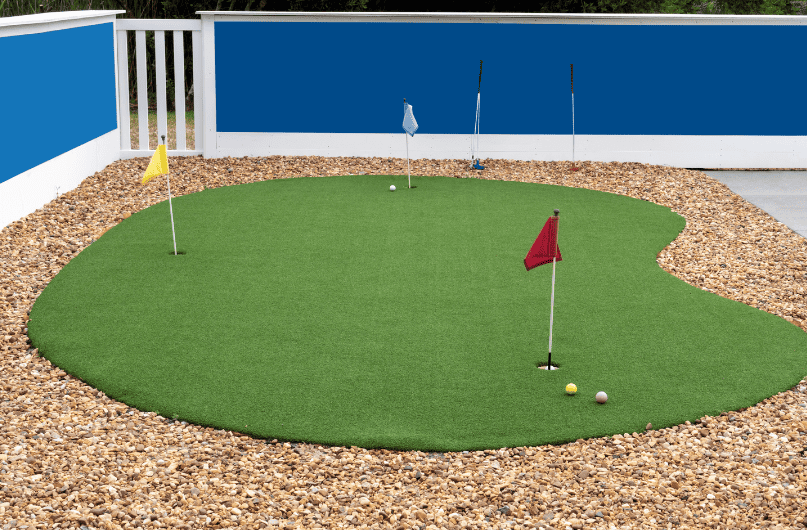
Unlike regular grass, artificial turf does not require the use of pesticides or fertilizers, making it a safer option for kids who may ingest or come into contact with the harmful chemicals on regular grass. Artificial turf is made from non-toxic materials and does not pose a risk of exposure to pesticides or fertilizers.
Additionally, artificial turf provides a cushioned surface that helps prevent injuries. The fibers of artificial grass provide a soft and cushioned surface when kids take tumbles and fall, reducing the risk of scraped knees, elbows, and heads that come with harder natural grass or concrete surfaces.
Many artificial grass manufacturers design their products with safety top of mind, using materials intended to mimic the play experience of natural grass while avoiding the risks that can come with real grass. With proper installation and maintenance, artificial turf can be an ideal surface for kids to play. The lack of fertilizers and pesticides combined with cushioning from the turf fibers and infill make artificial grass a safer option compared to natural grass or other hard surfaces.
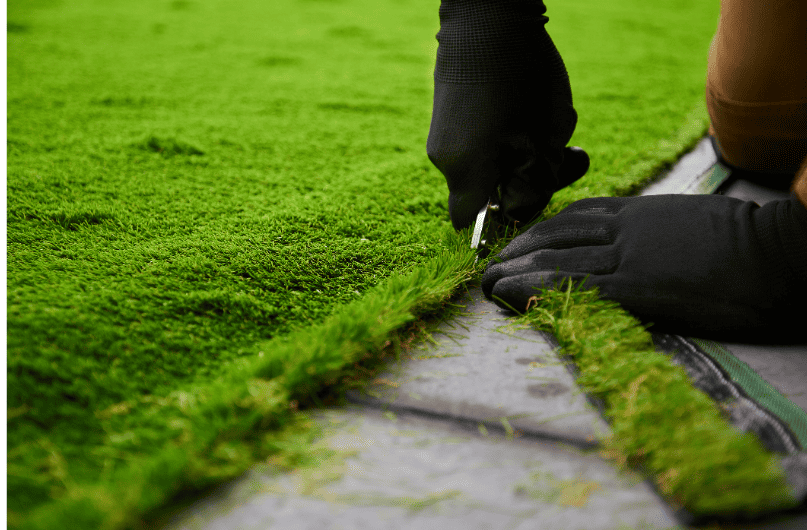
Real Landscaping is your go-to service provider for professional artificial grass installation. With vast experience in the industry, our skilled team ensures your artificial lawn is not only visually stunning but also long-lasting and low-maintenance.
We take pride in our meticulous attention to detail, and our comprehensive installation process includes the following steps:
At Real Landscaping, we understand that proper base preparation is crucial to the overall appearance and longevity of your artificial turf. We expertly dig out the area to an appropriate depth, remove any plants, roots, stones, and debris, and compact the soil until it's entirely flat and even. Our team also installs and compacts an appropriate aggregate base, ensuring the finished surface is perfectly smooth and slightly above surrounding surfaces.
We make sure the artificial grass is acclimated to the temperature before installation. Our team carefully trims and stretches the turf to fit your unique area, secures the edges with landscaping stakes, and meticulously cuts and glues seams between pieces for a flawless finish.
To give your artificial grass the necessary weight and support, our team uses clean silica sand and rubber granules specifically designed for this purpose. Following a standard mixture ratio, we use a drop spreader to evenly distribute the infill, ensuring the turf fibers stand upright and maintain their structural integrity.
Real Landscaping is committed to your satisfaction. After installation, we monitor the artificial grass to ensure it compresses and settles correctly with the infill. Our team is attentive to any uneven areas and will top up infill as needed to maintain a consistently lush appearance.
Choose Real Landscaping for professional artificial grass installation services. We guarantee exceptional quality, longevity, and aesthetics that will elevate your outdoor living experience.
One of the major benefits of artificial grass is the low maintenance required compared to natural lawn. While completely maintenance-free grass doesn't exist, caring for artificial turf is simple and straightforward.
With just a few minor tasks, artificial grass will retain its fresh, lush appearance for years. The maintenance required depends on the amount of traffic, but most artificial lawns need:
With proper installation and just a few minutes each week for these tasks, artificial grass remains lush and green while natural grass would require frequent mowing, watering, fertilizing and treatment for weeds or pests. The minimal effort makes artificial turf the low maintenance option.
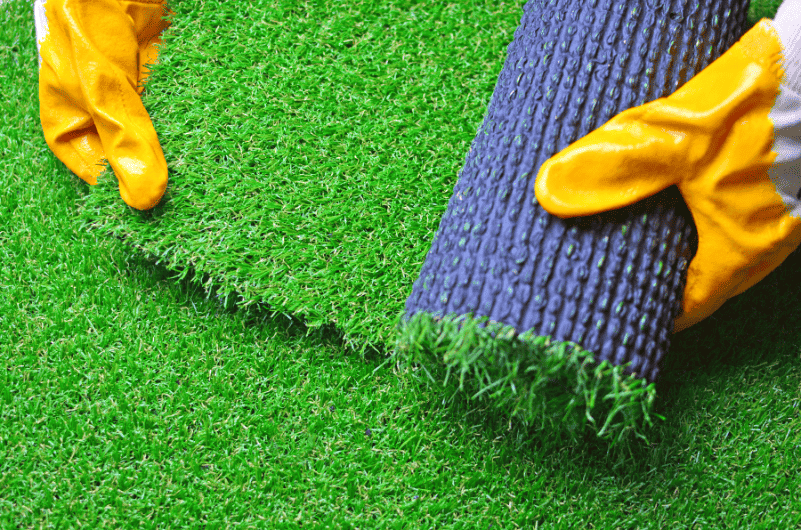
When selecting artificial grass for your home, it's important to look at a few key factors to ensure you choose a high-quality product.
Pile height refers to the length of the grass blades and pile density is how close together the blades are. For residential use, look for pile heights between 20mm and 40mm for a natural look. The pile density should be high, around 70 ounces per square meter, so the blades stand up properly and feel plush underfoot. Higher pile height and density equals a fuller, more luxurious lawn.
Quality artificial grass has strong backing to provide stability and drainage. Polypropylene backing is durable and allows water to flow through. A permeable backing prevents water pooling on the surface. Some options also have a latex coating for additional strength and stability.
At Real Landscaping, we provide more than just quality turf. Our comprehensive service guarantees a seamless experience from the beginning to the end. From helping you choose the right product to expert installation services, we ensure complete customer satisfaction. We support you through each step of the process, with a dedicated team to answer your queries and facilitate your decisions. Our goal is to make sure your new artificial lawn not only matches but exceeds your expectations.
As you compare various products, always check that the pile height, density, and service quality cater to your needs. Opting for the highest quality materials complemented by professional service will make sure your new artificial lawn maintains its beauty for several years.
Installing artificial grass is a great way to transform your outdoor space, but there are some safety considerations to keep in mind. Proper installation is key to avoiding hazards.
Artificial grass requires a base layer of compacted gravel to allow for drainage. This base needs to be properly leveled and compacted. An uneven base can lead to bumps or depressions in the artificial turf that could cause tripping hazards. Take care to prepare the base thoroughly.
Standing water under artificial grass can lead to bacterial growth and a foul odor. Plus, water pooling can cause the turf to shift or stretch. Proper drainage is a must, including grading the area away from the house and installing a French drain system if needed. No shortcuts here.
Artificial grass gets extremely hot in the sun and retains heat. Always supervise small children or pets on artificial lawns on hot days to avoid burns. Synthetic turf also won't provide the same cushion as real grass, so increased risk of injuries from falls is possible. Close supervision is key.
With some smart preparation and care, artificial grass can be a safe addition to enhance your outdoor living space. Just remember to account for proper installation, drainage, and supervision when using your new synthetic lawn.
While artificial grass offers many benefits, it's not the only option for your lawn. Here are some alternatives to consider:
Natural grass remains a popular choice for lawns and landscapes. With proper care and maintenance, real grass can be lush, green, and beautiful. The feel of walking barefoot on natural grass can't be replicated by artificial turf.
However, real grass does require more work than fake grass. It needs regular mowing, watering, fertilizing, aerating, and weeding. Natural grass goes dormant and turns brown during cold winter months. It can also become patchy if it doesn't get enough sun, water, or care.
If you want a lower maintenance alternative to natural grass, consider options like:
Think about your lifestyle, budget, and goals for your landscape. Artificial grass offers convenience but has upfront costs. Other options like native plants or hardscaping may require more planning and work initially but have lower long-term maintenance. Consider all the alternatives to find the best landscape solution for your home.
In summary, artificial grass provides several key benefits for home owners in New Zealand. The most significant advantages are the cost savings from reduced water usage, easier maintenance without mowing or fertilizers, and the ability to enjoy a lush green lawn year-round regardless of weather conditions.
Artificial turf allows you to reclaim outdoor space that would otherwise be unusable during dry periods. It stays permanently green and doesn't require the time-consuming upkeep that natural grass does. Installation is relatively straightforward as well.
While real grass has its appeal, artificial alternatives have improved dramatically in look and feel. The newest synthetic grass mimics natural turf in appearance but without any of the hassles. It's pet-friendly, child-safe, and allows outdoor play space even when natural lawns dry out.
For New Zealanders wanting to reduce lawn care duties and water usage while gaining a pristine lawn that maximizes usable backyard area, artificial grass is an excellent solution. With the many types now available, you can find an artificial turf perfect for your home's needs and environment. Artificial grass allows you to enjoy the beautiful aesthetic of a lush lawn every day of the year.